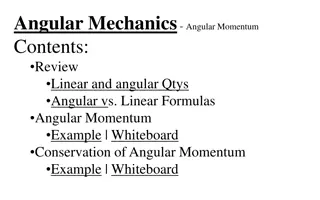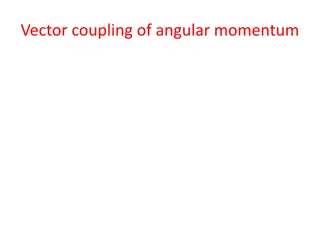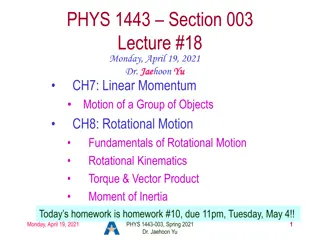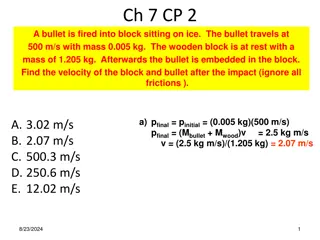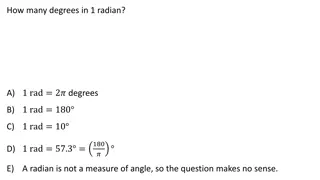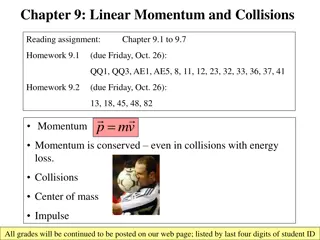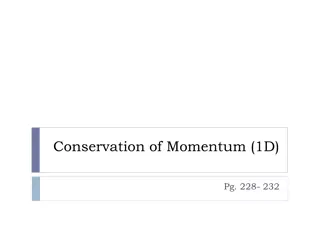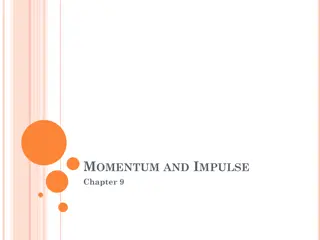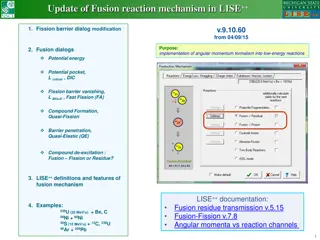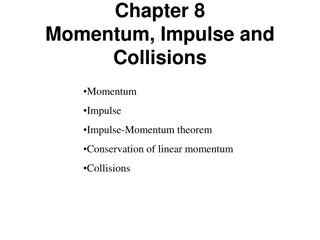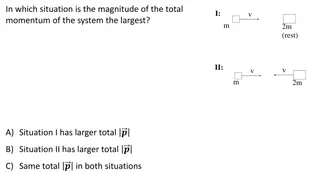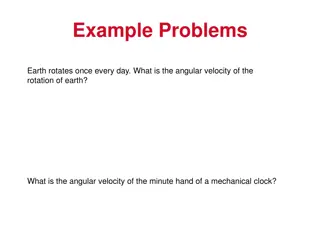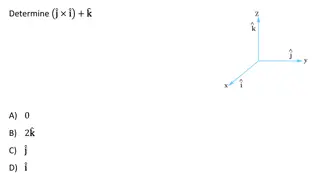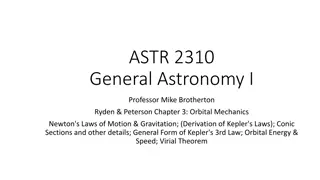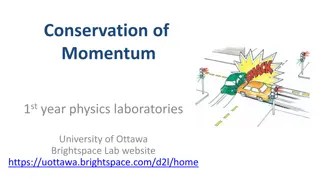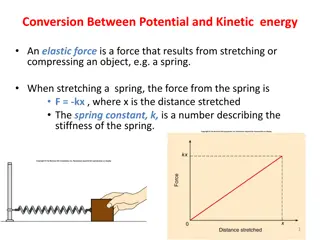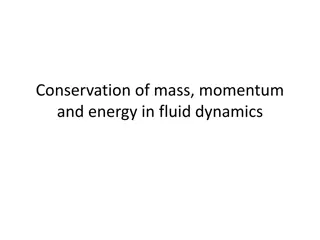Angular Momentum Conservation in Physics: Understanding Principles and Applications
Explore the concept of angular momentum conservation in physics, covering conditions for equilibrium, elastic properties of solids, density, specific gravity, fluid dynamics, pressure variations, and Pascal's Principle. Delve into examples like neutron star rotation and planetary motion to understand the implications of angular momentum conservation in different scenarios.
Download Presentation

Please find below an Image/Link to download the presentation.
The content on the website is provided AS IS for your information and personal use only. It may not be sold, licensed, or shared on other websites without obtaining consent from the author. Download presentation by click this link. If you encounter any issues during the download, it is possible that the publisher has removed the file from their server.
E N D
Presentation Transcript
PHYS 1443 Section 004 Lecture #20 Tuesday, Nov. 4, 2014 Dr. Jae Jaehoon Yu Angular Momentum Conservation Conditions for Equilibrium Elastic Properties of Solids Density and Specific Gravity Fluid and Pressure Variation of Pressure and Depth Pascal s Principle Yu Tuesday, Nov. 4, 2014 PHYS 1443-004, Fall 2014 Dr. Jaehoon Yu 1
Announcements Quiz results Class Average: 14.9/30 equivalent to 49.7/100 Top score: 27/30 Reminder 2nd Non-comprehensive term exam In class 9:30 10:50am, Thursday, Nov. 13 Covers CH 10.1 through what we finish Tuesday, Nov. 11 Mixture of multiple choice and free response problems Bring your calculator but DO NOT input formula into it! Your phones or portable computers are NOT allowed as a replacement! You can prepare a one 8.5x11.5 sheet (front and back) of handwritten formulae and values of constants for the exam None of the parts of the solutions of any problems No derived formulae, derivations of equations or word definitions! Do NOT Miss the exam! Tuesday, Nov. 4, 2014 PHYS 1443-004, Fall 2014 Dr. Jaehoon Yu 2
Conservation of Angular Momentum Remember under what condition the linear momentum is conserved? Linear momentum is conserved when the net external force is 0. By the same token, the angular momentum of a system is constant in both magnitude and direction, if the resultant external torque acting on the system is 0. 0 const Angular momentum of the system before and after a certain change is the same. constant = What does this mean? Ki+Ui= Kf+Uf Mechanical Energy Three important conservation laws for isolated system that does not get affected by external forces Linear Momentum Angular Momentum Tuesday, Nov. 4, 2014 PHYS 1443-004, Fall 2014 Dr. Jaehoon Yu 3
Ex. Neutron Star A star rotates with a period of 30 days about an axis through its center. After the star undergoes a supernova explosion, the stellar core, which had a radius of 1.0x104km, collapses into a neutron star of radius 3.0km. Determine the period of rotation of the neutron star. The period will be significantly shorter, because its radius got smaller. 1. 2. 3. Li= Lf Iiwi= Ifwf What is your guess about the answer? There is no external torque acting on it The shape remains spherical Its mass remains constant Let s make some assumptions: Using angular momentum conservation w =2p The angular speed of the star with the period T is Ii If 2p wf T 2 2 2p Ti 2p Ti mri mrf rf ri =ri wi= wf= Thus 2 2 rf Ti= 2 2 3.0 104 Tf= = 30days = 2.7 10-6days =0.23s 2 Tuesday, Nov. 4, 2014 PHYS 1443-004, Fall 2014 Dr. Jaehoon Yu 4
Keplers Second Law and Angular Momentum Conservation Consider a planet of mass Mp moving around the Sun in an elliptical orbit. Since the gravitational force acting on the planet is always toward radial direction, it is a central force Therefore the torque acting on the planet by this force is always 0. D A r r S dr dr B C 0 Since torque is the time rate change of angular momentum L L, the angular momentum is constant. Because the gravitational force exerted on a planet by the Sun results in no torque, the angular momentum L of the planet is constant. const Since the area swept by the motion of the planet is L L dA dt= dA= = const dt 2Mp 2Mp This is Keper s second law which states that the radius vector from the Sun to a planet sweeps out equal areas in equal time intervals. Tuesday, Nov. 4, 2014 PHYS 1443-004, Fall 2014 Dr. Jaehoon Yu 5
Similarity Between Linear and Rotational Motions All physical quantities in linear and rotational motions show striking similarity. Quantities Mass Linear M Rotational Moment of Inertia I mr = Mass 2 L Length of motion Speed Acceleration Force Work Power Momentum Kinetic Energy Distance Angle (Radian) w =Dq = v =Dr a = Dt Dt v t t Force Work Torque Work = W = P KR=1 1mv Kinetic Rotational K = 2Iw2 2 2 Tuesday, Nov. 4, 2014 PHYS 1443-004, Fall 2014 Dr. Jaehoon Yu 6
Conditions for Equilibrium What do you think the term An object is at its equilibrium means? The object is either at rest (Static Equilibrium) or its center of mass is moving at a constant velocity (Dynamic Equilibrium). When do you think an object is at its equilibrium? 0 Translational Equilibrium: Equilibrium in linear motion Is this it? The above condition is sufficient for a point-like object to be at its translational equilibrium. However for an object with size this is not sufficient. One more condition is needed. What is it? Let s consider two forces equal in magnitude but in opposite direction acting on a rigid object as shown in the figure. What do you think will happen? F F d CM The object will rotate about the CM. Since the net torque acting on the object about a rotational axis is not 0. For an object to be at its static equilibrium, the object should not have linear or angular speed. 0 d - -F F = = 0 0 CM v Tuesday, Nov. 4, 2014 PHYS 1443-004, Fall 2014 Dr. Jaehoon Yu 7
More on Conditions for Equilibrium To simplify the problem, we will only deal with forces acting on x-y plane, giving torque only along z-axis. What do you think the conditions for equilibrium be in this case? The six possible equations from the two vector equations turns to three equations. 0 0 x F = z = 0 AND y F = What happens if there are many forces exerting on an object? If an object is at its translational static equilibrium, and if the net torque acting on the object is 0 about one axis, the net torque must be 0 about any arbitrary axis. Why is this true? Because the object is not moving not moving, no matter what the rotational axis is, there should not be any motion. It is simply a matter of mathematical manipulation. r r O O r r5 5 Tuesday, Nov. 4, 2014 PHYS 1443-004, Fall 2014 Dr. Jaehoon Yu 8
Center of Gravity Revisited When is the center of gravity of a rigid body the same as the center of mass? Under the uniform gravitational field throughout the body of the object. Let s consider an arbitrary shaped object m x m x CM x i i = i i = m M The center of mass of this object is at i CMCoG m y m y y i i = i i = CM m M i Let s now examine the case that the gravitational acceleration on each point is g gi Since the CoG is the point as if all the gravitational force is exerted on, the torque due to this force becomes )CoG x + + = 2 2 1 1 1 g m x g m ( m m + + 2 1 ( + Generalized expression for different g g throughout the body + m g m g x ) 1 1 2 2 2 ( )g = + + = gx m x m x If g g is uniform throughout the body CoG x 1 1 2 x 2 m CM x i i = CoG m Tuesday, Nov. 4, 2014 PHYS 1443-004, Fall 2014 Dr. Jaehoon Yu 9 i
How do we solve static equilibrium problems? 1. Select the object to which the equations for equilibrium are to be applied. 2. Identify all the forces and draw a free-body diagram with them indicated on it & with their directions and locations properly indicated 3. Choose a convenient set of x and y axes and write down the force equation for each x and y component with correct signs. 4. Apply the equations that specify the balance of forces at equilibrium. Set the net force in the x and y directions equal to 0. 5. Select the most optimal rotational axis for torque calculations Selecting the axis such that the torque of one or more of the unknown forces become 0 makes the problem much easier to solve. 6. Write down the torque equation with proper signs. 7. Solve the force and torque equations for the desired unknown quantities. Tuesday, Nov. 4, 2014 PHYS 1443-004, Fall 2014 Dr. Jaehoon Yu 10
Example for Mechanical Equilibrium A uniform 40.0 N board supports the father and the daughter each weighing 800 N and 350 N, respectively, and is not moving. If the support (or fulcrum) is under the center of gravity of the board, and the father is 1.00 m from the center of gravity (CoG), what is the magnitude of the normal force n n exerted on the board by the support? 1m x Since there is no linear motion, this system is in its translational equilibrium Fx 0 = y F B M g 800 0 . 40 + = n n F D MFg g MDg g MBg g = n = M g 350 + = 0 M g 1190 F D n N Therefore the magnitude of the normal force Determine where the child should sit to balance the system. The net torque about the fulcrum by the three forces are Therefore to balance the system the daughter must sit = 0 g + . 1 g MD = MB + 00 0 MF g x 0 n M g 800 x = . 1 00 F m = . 1 = 00 . 2 29 m m M g 350 D Tuesday, Nov. 4, 2014 PHYS 1443-004, Fall 2014 Dr. Jaehoon Yu 11
Example for Mech. Equilibrium Contd Determine the position of the child to balance the system for different position of axis of rotation. Rotational axis 1m x n n x/2 F D The net torque about the axis of rotation by all the forces are MFg g MFg g MBg g ( . 1 ) 2 / = 0 = MB + + MD n / 2 00 / 2 g x MF g x g x / x 2 n MB ( M M = g . 1 = + + + M g M g M ( . 1 g D x g Since the normal force is B / + F D ) 2 / 2 + = 00 ) = 2 M 00 MF g M g M g D x g x g The net torque can be rewritten MD + / x 0 / 2 g x B g F . 1 F What do we learn? M 800 x Therefore = 00 F m = . 1 = No matter where the rotation axis is, net effect of the torque is identical. 00 . 2 29 m m M g 350 D Tuesday, Nov. 4, 2014 PHYS 1443-004, Fall 2014 Dr. Jaehoon Yu 12
Ex. Human Forearm A person holds a 50.0N sphere in his hand. The forearm is horizontal. The biceps muscle is attached 3.00 cm from the joint, and the sphere is 35.0cm from the joint. Find the upward force exerted by the biceps on the forearm and the downward force exerted by the upper arm on the forearm and acting at the joint. Neglect the weight of forearm. Since the system is in equilibrium, from the translational equilibrium condition 0 = F B = = 0 F FB B d x F F O = 0 mg F mg l l mg mg U + y F FU U mg l = 0 F F d l From the rotational equilibrium condition U B = FB l 50 d Thus, the force exerted by the biceps muscle is mg 0 . 35 0 . = = = 583 F N B . 3 00 = d = FB = F mg Force exerted by the upper arm is 583 50 0 . 533 N U Tuesday, Nov. 4, 2014 PHYS 1443-004, Fall 2014 Dr. Jaehoon Yu 13
Example: Ladder Balance A 5.0 m long ladder leans against a wall at a point 4.0m above the ground. The ladder is uniform and has mass 12.0kg. Assuming the wall is frictionless (but ground is not), determine the forces exerted on the ladder by the ground and the wall. First the translational equilibrium, using components F F = F FW W FBD = x F 0 mg g Gx W F FGy O Gy = + mg F = F 0 F FGx Gy y Gx Thus, the y component of the force by the ground is F = The length x0 is, from Pythagorian theorem mg = 12.0 9.8 = 118 N N Gy = = 2 2 5.0 4.0 3.0 x m 0 Tuesday, Nov. 4, 2014 PHYS 1443-004, Fall 2014 Dr. Jaehoon Yu 14
Example contd = + = 02 4.0 mg x F 0 From the rotational equilibrium O W Thus the force exerted on the ladder by the wall is mg x = = 02 118 1.5 4.0 = F 44 N W 4.0 The x component of the force by the ground is = = = = 44 F F N 0 F F F Solve for FGx Gx W x Gx W Thus the force exerted on the ladder by the ground is = + = + 2 2 2 2 F 44 118 F F 130N F F G Gx Gy 1 118 The angle between the ground force to the floor Gy = 1 = = o tan tan 70 44 Gx Tuesday, Nov. 4, 2014 PHYS 1443-004, Fall 2014 Dr. Jaehoon Yu 15


